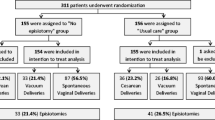Abstract
Objective
This retrospective study investigates the effects of mediolateral episiotomy on the pelvic floor.
Methods
Premenopausal women suffering from urinary incontinence/genital prolapse who delivered only by vaginal route were enrolled into the study. History of diabetes, morbid obesity (BMI > 40 kg/m2), vacuum/forceps extraction, perineal lacerations that warranted repair during labor and any pelvic surgery were the exclusion criteria. Evaluation of the patients included pelvic organ prolapse quantification scores, presence of stress incontinence, urethral hypermobility, and questionnaires were obtained for overactive bladder and anal incontinence symptoms. These data obtained from patients with the history of mediolateral episiotomy were compared with those of patients with no episiotomy or any other pelvic injury that warranted surgical repair.
Results
Groups were identical by means of demographic data, POP-Q findings, signs and symptoms of the pelvic floor. However, in the MLE group, central defects on the anterior vaginal wall were less frequent.
Conclusion
According to the results of this retrospective study, MLE seems to prevent central defects on the anterior vaginal wall. Prospective randomized studies are needed to draw a sufficient conclusion.
Similar content being viewed by others
References
Labrecque M, Baillargeon L, Dallaire M, Tremblay A, Pinault JJ, Gingras S (1997) Association between median episiotomy and severe perineal laceration in primiparous women. Can Med Assoc J 156:797–802
Thacker SB, Banta HD (1983) Benefits and risks of episiotomy: an interpretive review of the English language literature, 1860–1980. Obstet Gynecol Surv 38:22–38
Carroli G, Mignini L (2009) Episiotomy for vaginal birth. Cochrane Database Syst Rev (1):CD000081
Woolley RJ (1980) Benefits and risks of episiotomy: a review of the English-language literature since Part I. Obstet Gynecol Surv 50(11):806–820
Tegerstedt G, Maehle-Schmidt M, Nyren O, Hammarstrom M (2005) Prevalence of symptomatic pelvic organ prolapse in a Swedish population. Int Urogynecol J Pelvic Floor Dysfunct 16:497–503
Swift SE (2000) The distribution of pelvic organ support in a population of female subjects seen for routine gynecologic health care. Am J Obstet Gynecol 183:277–285
Swift S, Woodman P, O’Boyle A et al (2005) Pelvic organ support study (POSST): the distribution, clinical definition, and epidemiologic condition of pelvic organ support defects. Am J Obstet Gynecol 192:795–806
Nichols DH, Randall CL (1989) Types of genital prolapse. In: Randall CL, Nichols DH (eds) Vaginal Surgery, 3rd edn. Williams & Wilkins, Baltimore
Hartmann K, Viswanathan M, Palmieri R, Gartlehner G, Thorp J Jr, Lohr KN (2005) Outcomes of routine episiotomy: a systematic review. JAMA 293(17):2141–2148
Delivery Labor (2010) In: Cunningham FG, Leveno KJ, Bloom SL, Hauth JH, Rouse DJ, Spong CY (eds) Williams Obstetrics, 3rd edn. Baltimore, Williams & Wilkins, p 401
Angioli R, Gómez-Marín O, Cantuaria G, O’sullivan MJ (2000) Severe perineal lacerations during vaginal delivery: the University of Miami experience. Am J Obstet Gynecol 182(5):1083–1085
Eason E, Feldman P (2000) Much ado about a little cut: is episiotomy worthwhile? Obstet Gynecol 95(4):616–618
Eason E, Labrecque M, Wells G, Feldman P (2000) Preventing perineal trauma during childbirth: a systematic review. Obstet Gynecol 95(3):464–471
Signorello LB, Harlow BL, Chekos AK, Repke JT (2000) Midline episiotomy and anal incontinence: retrospective cohort study. BMJ 320(7227):86–90
American College of Obstetricians and Gynecologists (2006) Episiotomy. Practice Bulletin No. 71
Laine K, Gissler M, Pirhonen J (2009) Changing incidence of anal sphincter tears in four Nordic countries through the last decades. Eur J Obstet Gynecol Reprod Biol 146(1):71–75
Hendrix SL, Clark A, Nygaard I, Aragaki A, Barnabei V, McTiernan A (2002) Pelvic organ prolapse in the Women’s Health Initiative: gravity and gravidity. Am J Obstet Gynecol 186(6):1160–1166
Handa VL, Garrett E, Hendrix S, Gold E, Robbins J (2004) Progression and remission of pelvicorgan prolapse: a longitudinal study of menopausal women. Am J Obstet Gynecol 190(1):27–32
Brincat CA, Larson KA, Fenner DE (2010) Anterior vaginal wall prolapse: assessment and treatment. Clin Obstet Gynecol 53(1):51–58
Rooney K, Kenton K, Mueller ER, FitzGerald MP, Brubaker L (2006) Advanced anterior vaginal wall prolapse is highly correlated with apical prolapse. Am J Obstet Gynecol 195(6):1837–1840
Summers A, Winkel LA, Hussain HK, De Lancey JO (2006) The relationship between anterior and apical compartment support. Am J Obstet Gynecol 194(5):1438–1443
Delancey JO (2002) Fascial and muscular abnormalities in women with urethral hypermobility and anterior vaginal wall prolapse. Am J Obstet Gynecol 187(1):93–98
DeLancey JO (1999) Structural anatomy of the posterior pelvic compartment as it relates torectocele. Am J Obstet Gynecol 180(4):815–823
Kudish BI, Iglesia CB (2010) Posterior wall prolapse and repair. Clin Obstet Gynecol 53(1):59–71
Bodner-Adler B, Bodner K, Kaider A, Wagenbichler P, Leodolter S, Husslein P, Mayerhofer K (2001) Risk factors for third-degree perineal tears in vaginal delivery, with an analysis of episiotomy types. J Reprod Med 46(8):752–756
Shiono P, Klebanoff MA, Carey JC (1990) Midline episiotomies: more harm than good? Obstet Gynecol 75(5):765–770
Clemons JL, Towers GD, McClure GB, O’Boyle AL (2005) Decreased anal sphincter lacerations associated with restrictive episiotomy use. Am J Obstet Gynecol 192(5):1620–1625
Conflict of interest
None.
Author information
Authors and Affiliations
Corresponding author
Rights and permissions
About this article
Cite this article
Cam, C., Asoglu, M.R., Selcuk, S. et al. Does mediolateral episiotomy decrease central defects of the anterior vaginal wall?. Arch Gynecol Obstet 285, 411–415 (2012). https://doi.org/10.1007/s00404-011-1965-z
Received:
Accepted:
Published:
Issue Date:
DOI: https://doi.org/10.1007/s00404-011-1965-z




